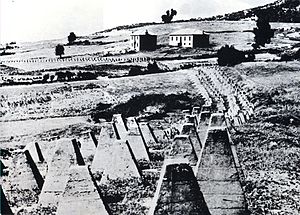
Back Линия „Метаксас“ Bulgarian Metaxasova linie Czech Metaxas-Linie German Γραμμή Μεταξά Greek Metaxas-linio Esperanto Línea Metaxás Spanish Metaxas-linja Finnish Ligne Metaxás French Metaxasova linija Croatian Մետաքսասի գիծ Armenian
This article needs additional citations for verification. (February 2019) |
| Metaxas Line | |
|---|---|
| Northeastern Greece | |
 Dragon's teeth along the Metaxas line, near the Greek–Bulgarian border | |
| Type | Defensive line |
| Site information | |
| Controlled by | Greece |
| Open to the public | Yes |
| Site history | |
| Built | 1936–1941 |
| In use | 1936–1945 |
| Materials | Concrete and steel |
| Battles/wars | Battle of Greece in World War II
|
The Metaxas Line (Greek: Γραμμή Μεταξά, Grammi Metaxa) was a chain of fortifications constructed along the line of the Greco-Bulgarian border, designed to protect Greece in case of a Bulgarian invasion after the rearmament of Bulgaria. It was named after Ioannis Metaxas, then Prime Minister of Greece, and chiefly consists of tunnels that led to observatories, emplacements and machine gun nests. The constructions are so sturdy that they survive to this day, some of which are still in active service. Some of them are open to the public.
The Metaxas Line consists of 21 independent fortification complexes, the largest of which is Fort Roupel as it covers 6.1 out of the 155 km of the full line and had been constructed at a height of 322 m. Illumination was initially mostly provided by oil-lamps, although generators were also installed. Currently, the fortifications are supplied with public electricity, but they are also equipped with generators. Ventilation was achieved both naturally and artificially. Water was supplied via water-mains. The fortification works lasted four years and their cost at the time reached 100,400,000 drachmas.